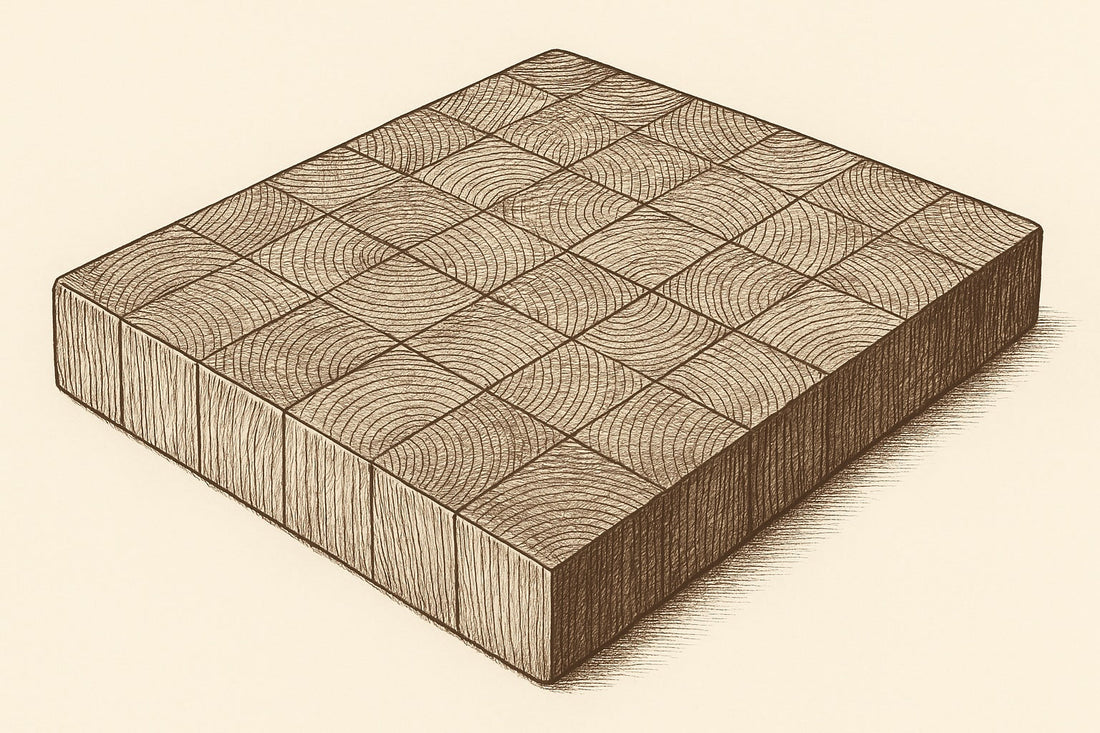
Best Cutting Boards for Your Knives: End-Grain vs Edge-Grain vs Plastic
Share
The cutting board you choose matters as much as the knife you use. The wrong surface can dull edges fast, make prep less safe, and turn simple tasks into a fight. This guide breaks down end-grain, edge-grain, bamboo, and plastic boards—so you can pick the surface that protects your knives and elevates your cooking.
Why Your Cutting Board Choice Matters
- Edge retention: Softer, “forgiving” boards help blades stay sharp longer; overly hard boards accelerate dulling.
- Food safety: Surface scarring and porosity affect how easily a board harbors bacteria—and how you sanitize it.
- Control & comfort: The right surface gives you stable contact, quieter cuts, and better confidence with every slice.
Related reading: Why Your Knives Go Dull (And How to Keep Them Sharp)
End-Grain Cutting Boards
What is End-Grain?
Blocks assembled with wood fibers oriented up (you’re cutting into the ends of the fibers). The surface “parts” slightly under the edge and closes back up—often called self-healing.
Pros
- Gentle on knife edges; excellent edge retention
- Self-healing surface hides marks
- Beautiful, heirloom look; substantial and stable
Cons
- Heavier and pricier than other options
- Needs regular oiling/waxing
- Can be bulky for small kitchens
Best for: Daily prepping with a chef’s knife, fine chopping, bread slicing with a serrated blade.
Edge-Grain Cutting Boards
What is Edge-Grain?
Boards glued with boards’ edges facing up. Fibers run parallel to the surface; slightly firmer feel than end-grain.
Pros
- More affordable than end-grain
- Durable, lighter, easy to handle
- Good balance of performance and price
Cons
- Shows knife marks sooner than end-grain
- Slightly harder on blades
- More prone to minor warping if neglected
Best for: Everyday prep, especially utility and paring work; great “first serious board.”
Bamboo Cutting Boards
Bamboo is fast-growing and eco-minded, but it’s naturally hard and often bonded with resins that further stiffen the surface.
- Pros: Lightweight, affordable, environmentally friendly, low water absorption.
- Cons: Harder on edges than wood; can feel slick; dents less but dulls more.
Best for: Light duty, serving boards, or a backup surface. If you choose bamboo, sharpen and hone a bit more often.
Related reading: Sustainable Cooking: Using Quality Tools to Reduce Kitchen Waste
Plastic Cutting Boards
Usually made from HDPE or polypropylene. Popular in professional kitchens for color-coding and easy sanitation.
- Pros: Dishwasher-safe; color-code for proteins vs produce; affordable and lightweight.
- Cons: Scars easily and can harbor bacteria in grooves; hard on edges; needs replacing regularly; can shed microplastics that end up in food.
Best for: Dedicated raw protein board that you can sanitize thoroughly in the dishwasher.
Glass, Marble, & “Pretty” Stone Boards
They look great, but they’re extremely hard. Cutting on stone or glass will dull (or chip) edges quickly.
- Use for: Serving only (cheese, charcuterie, presentation).
- Avoid for: Any knife work.
Quick Comparison
| Board Type | Edge Friendliness | Care | Sanitation | Cost | Best Use |
|---|---|---|---|---|---|
| End-Grain Wood | ★★★★★ | Oil/wax regularly | Good with proper care | $$$ | Primary board for daily prep |
| Edge-Grain Wood | ★★★★☆ | Oil as needed | Good with proper care | $$ | Everyday, value-forward choice |
| Bamboo | ★★★☆☆ | Low to moderate | Good | $ | Light prep, serving |
| Plastic | ★★★☆☆ | Dishwasher-safe | Very good (DW) | $ | Raw proteins, backups |
| Glass/Stone | ★☆☆☆☆ | Minimal | Good | $$ | Serving only |
So, What’s the Best Cutting Board for Your Knives?
- End-grain wood is the top choice for protecting sharp edges and enjoying a quiet, controlled cut.
- Edge-grain wood offers most of the benefits at a friendlier price and weight—great for first-time buyers.
Pair a quality board with sharp, well-balanced knives and your prep instantly feels cleaner, safer, and more precise.
Maintenance Tips: Boards & Knives
For Wood Boards
- Oil monthly (more in dry climates): apply food-safe mineral oil; seal with board wax if desired.
- Never soak; avoid the dishwasher. Wipe, wash quickly with mild soap, rinse, and dry upright.
- Salt + lemon (or a baking soda paste) lifts odors and stains naturally.
- Use non-slip feet or a damp towel under the board for stability.
For Plastic Boards
- Dishwasher sanitize regularly; replace when grooves become deep or fuzzy.
- Color-code to avoid cross-contamination (proteins vs produce).
For Your Knives
- Hone lightly and often; sharpen as needed based on feel and performance.
- Hand-wash and dry immediately; avoid the dishwasher.
- Store safely (sheaths, in-drawer blocks, or a stable block).
Related reading: Honing vs. Sharpening: What’s the Difference? | Knife Blocks vs. Magnetic Strips: What’s Best for Your Kitchen?
FAQs
Is end-grain really better than edge-grain?
For pure edge protection, yes—end-grain is gentler and self-healing. Edge-grain remains a fantastic value and suits most kitchens.
How often should I oil a wood board?
About once a month, or whenever the surface looks dry or feels rough. In drier seasons, oil more frequently.
Can bamboo damage my knives?
“Damage,” no; but bamboo’s hardness can dull edges faster. If you prefer bamboo, plan on more frequent honing/sharpening.
Finish Strong: Pair the Right Board with the Right Knife
Protecting your edges starts at the surface you cut on. Choose an end- or edge-grain board for everyday prep, keep a plastic board for proteins, and let stone or glass shine at the table—not under your blade.
Ready to feel the difference a sharp, balanced knife makes on the right board? Explore the SEKKIN Collection.
